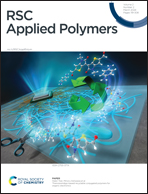How introduction of hydrolyzable moieties in POx influences particle formation – a library approach based on block copolymers comprising polyesters†
Abstract
A library of twelve fully degradable, amphiphilic block copolymers based on degradable poly(2-alkyl-2-oxazoline) analogues (dPAOx) and polyesters was synthesized via strain-promoted azide–alkyne cycloaddition of azido terminated dPAOx and cyclooctyne-initiated poly(ε-caprolactone) or poly(L-lactic acid), respectively. Different amounts of glycine moieties (15%, 32% and 47%) were incorporated in the hydrophilic dPAOx through oxidation of poly(ethylene imine) and consecutive re-acylation using acetyl or propionyl chloride. The resulting block copolymers were characterized in detail by means of NMR spectroscopy, size exclusion chromatography and matrix-assisted laser desorption ionization mass spectrometry. The polymers’ degradability was confirmed by a stepwise hydrolysis of the polyesters under alkaline conditions, followed by cleavage of the dPAOx under acidic conditions. A high-throughput nanoprecipitation method using a liquid handling robot was applied to investigate the influence of the glycine moieties on the particle formulation and the stability in direct comparison to block copolymers comprising poly(2-ethyl-2-oxazoline)s (PEtOx). Stable particle dispersions were obtained for most formulations even without the utilization of surfactants. Electrophoretic light scattering revealed an increase of the zeta potential with increasing amount of glycine units in all cases, an effect which appeared more prominent for the degradable PEtOx based block copolymers compared to those comprising degradable poly(2-methyl-2-oxazoline). The new amphiphilic block copolymers seem promising for encapsulation of drugs into fully degradable carrier materials.



 Please wait while we load your content...
Please wait while we load your content...